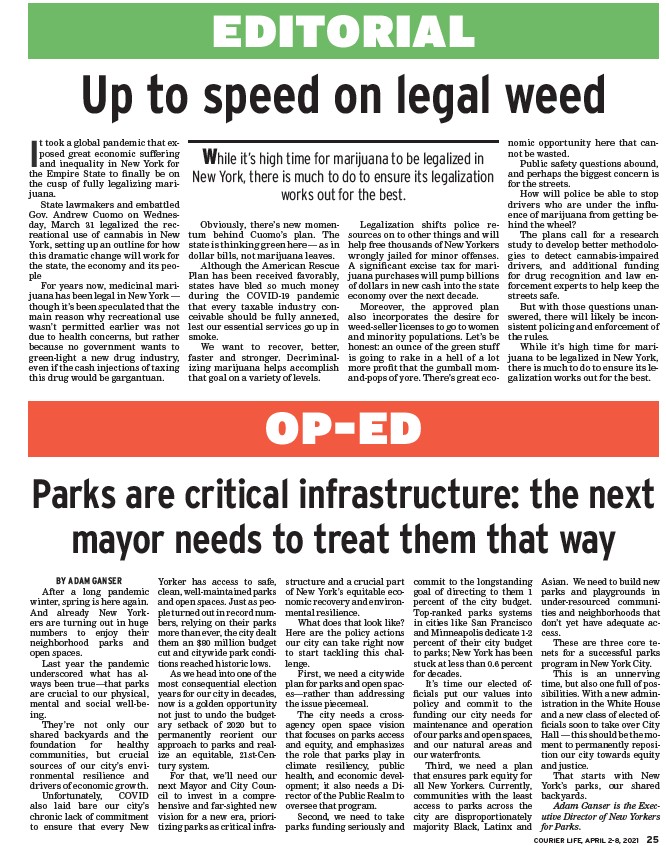
Parks are critical infrastructure: the next
mayor needs to treat them that way
COURIER LIFE, APRIL 2-8, 2021 25
EDITORIAL
Up to speed on legal weed
It took a global pandemic that exposed
great economic suffering
and inequality in New York for
the Empire State to fi nally be on
the cusp of fully legalizing marijuana.
State lawmakers and embattled
Gov. Andrew Cuomo on Wednesday,
March 31 legalized the recreational
use of cannabis in New
York, setting up an outline for how
this dramatic change will work for
the state, the economy and its people
For years now, medicinal marijuana
has been legal in New York —
though it’s been speculated that the
main reason why recreational use
wasn’t permitted earlier was not
due to health concerns, but rather
because no government wants to
green-light a new drug industry,
even if the cash injections of taxing
this drug would be gargantuan.
Obviously, there’s new momentum
behind Cuomo’s plan. The
state is thinking green here — as in
dollar bills, not marijuana leaves.
Although the American Rescue
Plan has been received favorably,
states have bled so much money
during the COVID-19 pandemic
that every taxable industry conceivable
should be fully annexed,
lest our essential services go up in
smoke.
We want to recover, better,
faster and stronger. Decriminalizing
marijuana helps accomplish
that goal on a variety of levels.
Legalization shifts police resources
on to other things and will
help free thousands of New Yorkers
wrongly jailed for minor offenses.
A signifi cant excise tax for marijuana
purchases will pump billions
of dollars in new cash into the state
economy over the next decade.
Moreover, the approved plan
also incorporates the desire for
weed-seller licenses to go to women
and minority populations. Let’s be
honest: an ounce of the green stuff
is going to rake in a hell of a lot
more profi t that the gumball momand
pops of yore. There’s great economic
opportunity here that cannot
be wasted.
Public safety questions abound,
and perhaps the biggest concern is
for the streets.
How will police be able to stop
drivers who are under the infl uence
of marijuana from getting behind
the wheel?
The plans call for a research
study to develop better methodologies
to detect cannabis-impaired
drivers, and additional funding
for drug recognition and law enforcement
experts to help keep the
streets safe.
But with those questions unanswered,
there will likely be inconsistent
policing and enforcement of
the rules.
While it’s high time for marijuana
to be legalized in New York,
there is much to do to ensure its legalization
works out for the best.
OP-ED
BY ADAM GANSER
After a long pandemic
winter, spring is here again.
And already New Yorkers
are turning out in huge
numbers to enjoy their
neighborhood parks and
open spaces.
Last year the pandemic
underscored what has always
been true—that parks
are crucial to our physical,
mental and social well-being.
They’re not only our
shared backyards and the
foundation for healthy
communities, but crucial
sources of our city’s environmental
resilience and
drivers of economic growth.
Unfortunately, COVID
also laid bare our city’s
chronic lack of commitment
to ensure that every New
Yorker has access to safe,
clean, well-maintained parks
and open spaces. Just as people
turned out in record numbers,
relying on their parks
more than ever, the city dealt
them an $80 million budget
cut and citywide park conditions
reached historic lows.
As we head into one of the
most consequential election
years for our city in decades,
now is a golden opportunity
not just to undo the budgetary
setback of 2020 but to
permanently reorient our
approach to parks and realize
an equitable, 21st-Century
system.
For that, we’ll need our
next Mayor and City Council
to invest in a comprehensive
and far-sighted new
vision for a new era, prioritizing
parks as critical infrastructure
and a crucial part
of New York’s equitable economic
recovery and environmental
resilience.
What does that look like?
Here are the policy actions
our city can take right now
to start tackling this challenge.
First, we need a citywide
plan for parks and open spaces—
rather than addressing
the issue piecemeal.
The city needs a crossagency
open space vision
that focuses on parks access
and equity, and emphasizes
the role that parks play in
climate resiliency, public
health, and economic development;
it also needs a Director
of the Public Realm to
oversee that program.
Second, we need to take
parks funding seriously and
commit to the longstanding
goal of directing to them 1
percent of the city budget.
Top-ranked parks systems
in cities like San Francisco
and Minneapolis dedicate 1-2
percent of their city budget
to parks; New York has been
stuck at less than 0.6 percent
for decades.
It’s time our elected offi
cials put our values into
policy and commit to the
funding our city needs for
maintenance and operation
of our parks and open spaces,
and our natural areas and
our waterfronts.
Third, we need a plan
that ensures park equity for
all New Yorkers. Currently,
communities with the least
access to parks across the
city are disproportionately
majority Black, Latinx and
Asian. We need to build new
parks and playgrounds in
under-resourced communities
and neighborhoods that
don’t yet have adequate access.
These are three core tenets
for a successful parks
program in New York City.
This is an unnerving
time, but also one full of possibilities.
With a new administration
in the White House
and a new class of elected offi
cials soon to take over City
Hall — this should be the moment
to permanently reposition
our city towards equity
and justice.
That starts with New
York’s parks, our shared
backyards.
Adam Ganser is the Executive
Director of New Yorkers
for Parks.
While it’s high time for marijuana to be legalized in
New York, there is much to do to ensure its legalization
works out for the best.